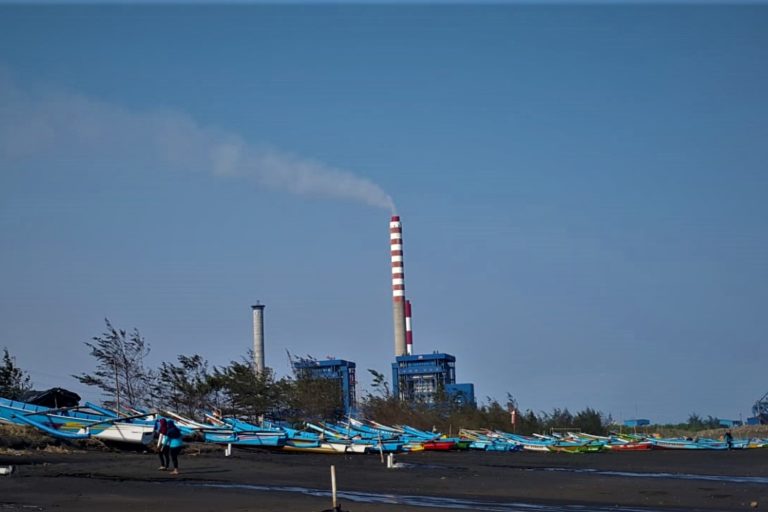- Hundreds of people in central Java earlier this week staged a protest demanding a resolution over waste mismanagement at a coal-fired power plant that has polluted their village.
- Residents of the village of Winong have since 2016 blamed the Cilacap plant and its Jakarta-based operator for polluting their air and depleting the water table.
- The local environment agency had carried out an investigation last year and ordered the operator to take measures to remedy the problem.
- However, the results of that investigation were not released untilthis week, and then only after protests from the villagers. The evaluation of the remedial measures has still not been published.
CILACAP, Indonesia — Hundreds of people in this city in central Java staged a protest this week demanding a meaningful solution to a long-running air pollution problem caused by ash from a coal-fired power plant.
The protesters, from the village of Winong in Cilacap district, gathered outside the district environment agency office on Sept. 30 to call for sanctions against PT Sumber Segara Primadaya (S2P), which operates the Cilacap power plant. They carried signs that read “The People Need Clean Air” and “The People Are Showered by Coal Dust,” as well as “We Need Proof, Not Promises,” in reference to previous statements by local officials vowing to resolve the problem.


Residents of Winong, a village of fewer than a thousand people, have since 2016 blamed the power plant for polluting the water and air in area. They say the plant’s operations have depleted the water table, and that any water they can draw up from their wells is salty. They also complain of a constant rain of ash peppering their homes, forcing them to clean up every day. Local children have reportedly been diagnosed with pollution-related ailments, including bronchitis and skin rashes.
The plant, including its waste management facility, known as the ash yard, is located just 20 meters (66 feet) away from the village.
After multiple complaints and protests, the villagers finally got an opportunity to make their case to the Cilacap district head, Tatto Suwarto Pamuji, in August 2018. Following that meeting, Tatto ordered an investigation the next month into the plant and the operator. The investigation involved environmental experts from Diponegoro University in Semarang, the Central Java provincial capital, and two of the Winong villagers.
But the results of that investigation were never made public, according to Agus Mulyadi, from the Forum for Winong People Care for the Environment (FMWPL), who was present at the meeting with Tatto. Instead, the Cilacap environment agency and PT S2P met in November 2018 with the villagers to resolve the air pollution and mismanaged waste — without ever revealing the true scale of the problem. The agreement also called for an evaluation of the company’s efforts after four months.
That evaluation was due this past March. “But as of September, there has been no evaluation,” Agus said, adding that the people were still suffering from the pollution attributed to the plant and its ash yard.
“We don’t care how, but the point is, the ash yard has to be relocated because it has clearly polluted the environment, especially in Winong,” Agus added.


At their protest this week, the villagers met with Awaludin Muri, the environment agency head. They told him that their village continued to be enveloped in dust, adding “Please resolve this. Don’t let us continue to be victims of pollution.”
The pressure appeared to pay off, with Awaludin handing over the results of the investigation to the crowd. In doing so, he said he had “paid off one of the people’s demands.”
But another demand that remains unfulfilled is the publication of the promised evaluation of the plant operator’s efforts to address the problem. The protesters gave Awaludin’s team a deadline to resolve the issue within a month.
“We acknowledge, because we’ve also gone to the site, that pollution is still happening,” Awaludin said. “In principle, we are working. But it’s unlikely to be resolved in a month.”
Awaludin also said there had been a delay in efforts to contain the pollution from the ash yard. “The Cilacap [district] environment agency and the Central Java [provincial] environment agency have been working together with PT S2P on the environmental impact assessment,” he said.
He added his office would boost efforts to manage the environmental impact in Winong from the power plant, including creating a dome to contain the ash from burning coal, and spraying water to prevent the ash from dispersing into the air.

This story was first reported by Mongabay’s Indonesia team and published here on our Indonesian site on Oct. 3, 2019.
FEEDBACK: Use this form to send a message to the author of this post. If you want to post a public comment, you can do that at the bottom of the page.